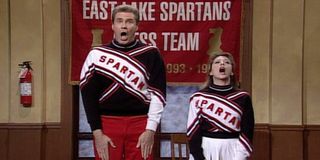One Big Way SNL Has Gotten More Complicated Over The Years

Over the last four decades, Saturday Night Live has transformed from a simple, weekly comedy show into a cultural go-to source of political satire, delightful celebrity impersonations, and weird sketches. As the brainchild of Lorne Michaels, the series has evolved through the years as cast lineups change, and one of the most important aspects of the show has always been its non-human stage sets. It turns out that the design of these sets has become considerably more complicated over time, and when I recently asked SNL's longtime Production Designer Eugene Lee about this evolution, he explained the process, saying:
Over the arc of the show, I mean if one looks at the total arc, it was simpler back in the beginning. Simpler sets. A talk show set was like a potted plant and a couch or something. So it's gotten more realistic because people want it more movie-like. They want it more detailed. They want it more real. I mean, in the early years we tried things like one living room with different pieces. You know? A living room that had a stairway that went to the upper floor. Various living rooms that we could re-arrange in pieces. But that's no longer. Everything now, they want it more realistic. They want it more like a film set. We can't do that of course but that's what they want.
As Saturday Night Live has matured in prominence and technical sophistication, audiences and crewmembers alike have demanded a higher level of production value from the show's visuals. (High-def TV hasn't helped that, either.) To accommodate this requirement, Eugene Lee and his crew have found themselves forced to devise far more complex pieces of scenery that look and feel more authentic.
Rather than reusing basic, bare-bones floorplans and recycling designs from scene to scene, the show now finds itself creating deeper sets with increasingly realistic props and scenery that attempt (but don't always manage) to recreate the aesthetic of a full-fledged film set. By this style of thinking, classic SNL bits like "Land Shark," "Samurai Hotel," and "Consumer Probe" would be considered crude when compared to today's considerably larger sets.
Creating more immersive and realistic sets obviously has its own set of advantages for the performers (and by extension, the entire show) in the long run, but those benefits come with some significant drawbacks as well. Specifically, these more elaborate sets have forced the stage crew to sacrifice space that previously would've been reserved for members of the audience. Eugene Lee continued:
You look at the early years. There wasn't so much scenery done. In recent years we do a lot more scenery. So it ends up where the audience used to be. So we lose audience to do more scenery. You know?
Of course, knowing how much the set design impacts the size of the audience presents an interesting thought experiment about the importance of crowd size for Saturday Night Live. While a big and active audience will always be essential for the show's increasingly live performances, prerecorded skits like Bern Your Enthusiasm continue to become some of the show's most talked about segments. With digital shorts like this consistently serving as some of SNL's most popular and successful bits, Eugene Lee and his team can undoubtedly devote more time to establishing more intricate sets that will work better for an admittedly smaller in-studio crowd. It's a tradeoff, but it seems to have worked so far.
Saturday Night Live will return to NBC with new episodes this fall, and Saturday Night Live: Weekend Update (the primetime spinoff of the show's satirical news segment) will make its debut later this summer on Thursday, August 10, at 9 p.m. EST. If you're looking for more information concerning the rest of this summer's major TV debuts, check out our summer TV premiere guide for more details!
CINEMABLEND NEWSLETTER
Your Daily Blend of Entertainment News
Originally from Connecticut, Conner grew up in San Diego and graduated from Chapman University in 2014. He now lives in Los Angeles working in and around the entertainment industry and can mostly be found binging horror movies and chugging coffee.
Most Popular







